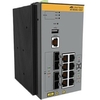-
Home
-
Contributors
-
International
-
Account
-
Information
More From Contributor
- 3 Layer Supported
- Modular
- Optical Fiber, ...
- Allied Ware Plus™ operating system
- Autonomous Management Framework™ (AMF) edge node
- Active Fiber Monitoring
- Ethernet Protection Switched Ring (EPSR™)
- Po E power budget of 740 Watts
- Continuous Power over Ethernet (Po E+)
- Static Routing & RIP
- DHCP snooping
- IEEE 802.1x/MAC/ Web authentication support
- Loop Protection
- Eco-friendly
- Web-based Graphical User Interface (GUI) ...
- PSU
- FAN
Specification Input Voltage 100-240 VAC 50/60 Hz Output Voltage 12 volts & 3.3 volts Operating Temperature: 0° C to 40° C
- (32° F to 104° F) Storage Temperature: -20° C to 70° C
- (-° 4F to 158° F) Operating Humidity: Less than 80% noncondensing Storage Humidity: Less than 95% noncondensing Maximum Operating Altitude: 3, 048 m (10, 000 ft) Maximum Nonoperating Altitude: 4, 000 m (13, 000 ft) ...
- 3 Layer Supported
- Modular
- 240 W Po E Budget
- Twisted ...
- 3 Layer Supported
- Modular
- Twisted Pair, Optical Fiber
- ...
- 2 Layer Supported
- Modular
- Optical Fiber, Twisted Pair
- DIN Rail ...
- 2 Layer Supported
- Modular
- Optical Fiber, Twisted Pair
- ...
Specification for Virtual LANs (VLANs) that send extra- long data packets on the network. The MMC2000 switches are fully compatible with these long packets, enabling them to be used in modern networks. Media converters not supporting this feature discard these extra long packets, making them unsuitable for modern networks. Small & Flexible The smaller size & external power supply of the MMC2000 Series allows them to be used almost anywhere. Smart Missing Link (SML) The Smart Missing Link (SML) feature monitors network connections & provides notification when network segments fail, allowing network managers to quickly identify the source & location of failed segments & minimize downtime. Smart Link Restoration Smart Link restoration allows the devices, in cases of power failure, link loss or other interrupted service, to automatically restore the link without the need to restart/reset them. Power Saving The MMC Series continues the Allied Telesis commitment to the environment with over 50% power savings. With just 1.7W of power usage, the MMC Series media converters are some of the most efficient in the market today. ...
Allied Telesis IMC2000TP/SC - Transceiver/Media Converter - TAA
Compliant
multimode, single mode and BiDi optics. Models with a fixed fiber-optic port are available with SC or LC connectors. With these, you can achieve distances up to 2 km (100Mps) or 550 m (1000Mps). With the SFP model, you can achieve greater distances using a long-range SFP. In addition to transmitting data, the twisted-pair port also injects power down the cable, allowing a remote PoE powered device to operate without any additional power source. All PoE+ devices (IEEE802.3at compliant) are supported. All PoE+ devices support 802.3at, PoE+, LTPoE++ and 4-pair. The PC200x PoE+ Series can deliver up to 70W of power to the remote device. Remote Power Cycle The 200/2000 Series supports the Remote Power Cycle feature. When the fiber port is dropped, the TX PoE+ port cycles power. This
allows a remote administrator to log in to a switch and disable the switch port to which the IMC is attached, which causes the PoE+ device to lose power. This allows administrators to reset remote devices without physically going to the location. Jumbo frame support Many backbone switch products support the industry-standard IEEE 802.1Q specification for Virtual LANs (VLANs) which sends extra-long data packets on the network. The 200/2000 Series are fully compatible with these long packets, enabling them to be used in modern networks. Smart MissingLink™ (SML) The SML feature monitors network connections and provides a notification when a link fails, allowing administrators to quickly identify the source and location of failed links, and thus minimize downtime.
- External links may include paid for promotion
- Availability: In Stock
- Supplier: Ebuyer
- SKU: 1125931
Product Description
Allied Telesis IMC2000TP/SC Transceiver/ Media Converter
- TAA Compliant
- 2 Port (s)
- 1 x Network (RJ-45)
- 1 x SC
- Twisted Pair, Optical Fiber
- Multi-mode Fiber
- Gigabit Ethernet
- 10/100/1000 Base-T, 1000 Base-SX
- 550 m
- Standalone, Rail-mountable Powering remote devices Allied Telesis 200/2000 Series Industrial Media Converters (IMCs) are ideal for powering remote devices, such as IP phones, video cameras & wireless Access Points (APs), which are more than 100m from a Power over Ethernet (Po E) switch. Each IMC can provide up to 60W of Po E. The 2000T/SP & the 2000TP/SP each feature a 10/100/1000T twisted-pair port, & an SFP port which supports & auto detects 100X & 1000X optics. No switch configuration is needed. Allied Telesis offers a wide variety of SFPs featuring multimode, single mode & Bi Di optics. Models with a fixed fiber-optic port are available with SC or LC connectors. With these, you can achieve distances up to 2 km (100 Mps) or 550 m (1000 Mps). With the SFP model, you can achieve greater distances using a long-range SFP. In addition to transmitting data, the twisted-pair port also injects power down the cable, allowing a remote Po E powered device to operate without any additional power source. All Po E+ devices (IEEE802.3at compliant) are supported. All Po E+ devices support 802.3at, Po E+, LTPo E++ & 4-pair. The PC200x Po E+ Series can deliver up to 70W of power to the remote device. Remote Power Cycle The 200/2000 Series supports the Remote Power Cycle feature. When the fiber port is dropped, the TX Po E+ port cycles power. This allows a remote administrator to log in to a switch & disable the switch port to which the IMC is attached, which causes the Po E+ device to lose power. This allows administrators to reset remote devices without physically going to the location. Jumbo frame support Many backbone switch products support the industry-standard IEEE 802.1Q
Specification for Virtual LANs (VLANs) which sends extra-long data packets on the network. The 200/2000 Series are fully compatible with these long packets, enabling them to be used in modern networks. Smart Missing Link™ (SML) The SML feature monitors network connections & provides a notification when a link fails, allowing administrators to quickly identify the source & location of failed links, & thus minimize downtime.
Reviews/Comments
Add New
Intelligent Comparison
We couldn't find anything!
Perhaps this product's unique.... Or perhaps we are still looking for comparisons!
Click to bump this page and we'll hurry up.
Price History
Vouchers
Do you know a voucher code for this product or supplier? Add it to Insights for others to use.


 United Kingdom
United Kingdom
 France
France
 Germany
Germany
 Netherlands
Netherlands
 Sweden
Sweden
 USA
USA
 Italy
Italy
 Spain
Spain












 Denmark
Denmark